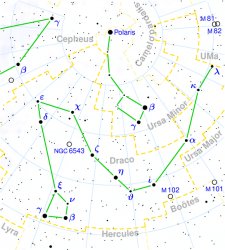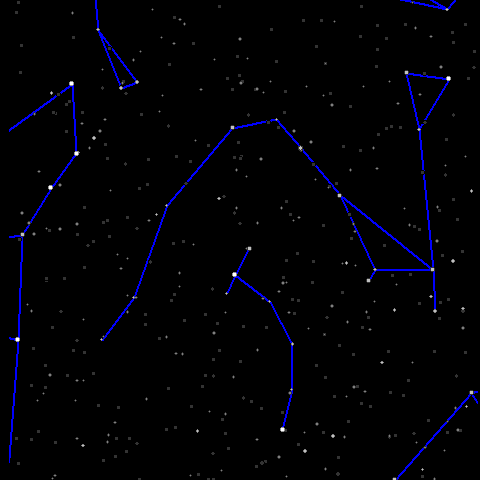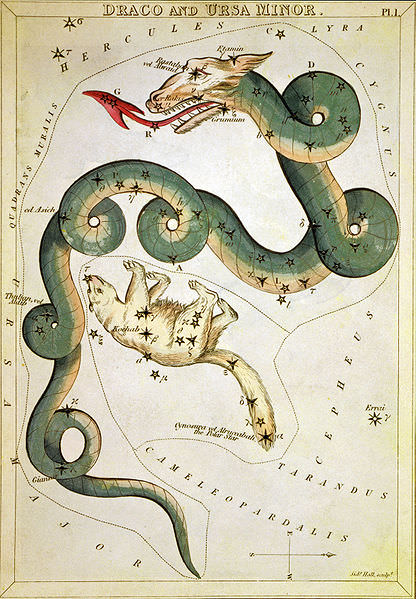Kids of all ages! With no Moon around to light up the weekend skies, isn’t it time to spend an evening outside an enjoy the stars? With Spring in the air in the northern hemisphere, the nights are much warmer and a welcome time to observe the glittering jewels that turn around Polaris, the “North Star”. This time we’re off on an adventure to help you identify the eight largest constellation in the night – Draco the Dragon…
 As the skies get dark tonight, go out and do some stargazing. One of the brightest you will see will be almost overhead – the planet Saturn. Do you recognize the “Big Dipper” – Ursa Major – to the north? Good! Connect the dots of the two stars on the front of the dipper and they will point the way to Polaris. Once you have this star in site, you are ready to find the Draco constellation. It’s a long, glittering chain of faint stars that curls around between Ursa Major and Polaris on the east side. Watch as the night goes on and the Dragon climbs higher. By midnight its stars will have curled over the top of Polaris!
As the skies get dark tonight, go out and do some stargazing. One of the brightest you will see will be almost overhead – the planet Saturn. Do you recognize the “Big Dipper” – Ursa Major – to the north? Good! Connect the dots of the two stars on the front of the dipper and they will point the way to Polaris. Once you have this star in site, you are ready to find the Draco constellation. It’s a long, glittering chain of faint stars that curls around between Ursa Major and Polaris on the east side. Watch as the night goes on and the Dragon climbs higher. By midnight its stars will have curled over the top of Polaris!
Listen… Do you hear a voice on the wind? I think it has a story for you…
 “What “knight’s” tale would not be complete without a battle with a dragon? Almost every ancient culture has a dragon in its myths! These huge serpents were believed to have a body like a huge lizard, or a snake with two pairs of lizard-type legs, and able to emit fire from their mouths. Even our English word, dragon, comes from the Greek word “drakon” meaning huge serpent! Perhaps the largest of all known dragons is portrayed in stars… the constellation of Draco.”
“What “knight’s” tale would not be complete without a battle with a dragon? Almost every ancient culture has a dragon in its myths! These huge serpents were believed to have a body like a huge lizard, or a snake with two pairs of lizard-type legs, and able to emit fire from their mouths. Even our English word, dragon, comes from the Greek word “drakon” meaning huge serpent! Perhaps the largest of all known dragons is portrayed in stars… the constellation of Draco.”

“But, do dragons really breathe fire? No, but the constellation of Draco is host to six different meteor showers. The best of all occurs around the middle of September every year, so be sure to watch. Perhaps it is the Japanese dragon “Ryu” and he will grant your wish!”
Images that accompany this article are: Historical Draco Figure from Uranometria, Draco Map Created by Torsten Bronger, Dragon Eggs Screensaver, and Animation by Michelet B. We thank you!


Wonderful ! 🙂
As a Cub Scout trying to earn a badge for astronomy, I found Draco most difficult in heavily light-polluted skies, while, at extremely dark sky sites (e.g. in Arizona, Mew Mexico, Nevada, & Utah), I ran into exactly the opposite problem: with so many faint stars visible, Draco just blended in with myriad other stars in that part of the sky! But, after years of practice, Draco is relatively easy to pick out in a clear, dark, transparent sky. Anyone else have a problem trying to identify dimmer constellations in a truly dark, pristine sky?
yeah, jon… even with star charts imprinted on my brain, i have trouble with portions of ophiuchus and serpens.
and we won’t even talk about camelopardalis. 😉
Would that be Serpens Cauda or Serpens Caput? And forget Camelopardalis, what’s up with Lynx 🙂 And for the deep Southern Hemisphere constellations (Octans, Microscopium, Triangulum Australe, Pictor…..) you might as well get a GoTo scope to figure your way around these barren patches of the sky. But, thanks, Tammy, on a constellation that is well known to me now.
you mean there’s a difference?!?!?
heheheheeeee…..
(see, folks? even people who are very, very familiar with the night sky don’t always find it easy. there are times when something a small as going to a different location will totally throw off the way i see things. it might be something as minor as having a building where i’m not used to seeing one… or something as major as a latitude and longtitude adjustment.)
and i will guarantee there is more than one of you out there (if you’re willing to admit it) that might know the basic position of things from season to season, but have to practice and learn again every time!
i sure do… 😉